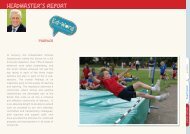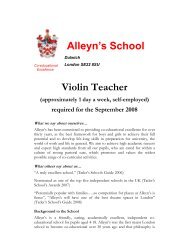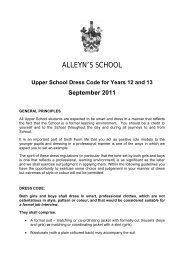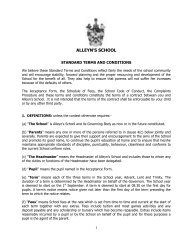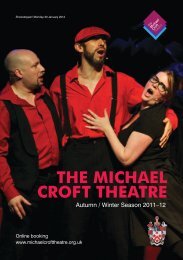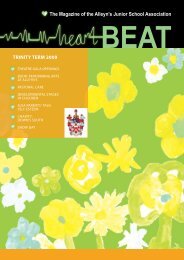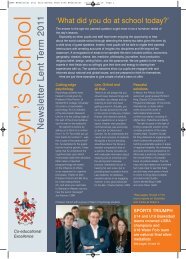EAC Magazine - Alleyn's School
EAC Magazine - Alleyn's School
EAC Magazine - Alleyn's School
You also want an ePaper? Increase the reach of your titles
YUMPU automatically turns print PDFs into web optimized ePapers that Google loves.
A l u m n in e w sRichard explained how the ABPI has to address and respond tothe needs of all its member organisations (of which there are70, ranging from multi-international companies to smallresearch outfits). If it doesn’t, it fails the industry it serves.Defending science spending Radio 4After this Richard caught up on his emails that came throughthat day – on average a whopping 200 of them! Whilst he hadbeen at these various meetings, Richard had been keeping intouch with the ABPI’s press office about Vince Cable’s speechon the coalition Government’s vision for investing in scienceand research. In this Cable asked scientists to abandon workthat is ‘neither commercially useful nor theoreticallyoutstanding’. The invitation to appear on the next day’s TodayProgramme to defend the contribution of science researchspending to future economic growth came through. So themorning we met Richard he had already been interviewed byJohn Humphries and warned the Government to ‘use a scalpeland not a hatchet’ when reviewing its spending on research.He explained how research in life sciences is a long-term twostageprocess: the first, those projects led by curiosity – such ashis own research into magnetic resonance that he carried outin the 1970s and; the second, translating those findings intodeveloping practical medicines and devices, such as MRIscanning which developed from basic research all those yearsago. The MRI scan has in turn led to another success storytoday, the discovery via MRI scans of the brains of patientswith early Alzheimer’s, that supplements of vitamin B sloweddown the shrinkage of their brains, compared to those patientswho hadn’t taken the vitamin B supplement. Researchers saythis could be the first step towards finding a way to delay theonset of Alzheimer’s.Richard enjoys his work immensely and describes it as ‘a funjob’. We talked about his time at school and he remembers howJohn Clarke, the Head of Chemistry, encouraged him inexperimental chemistry, even allowing him to work in the<strong>School</strong>’s laboratories after hours. He also credits the lateAlasdair Aston (see obituary, p23) for inspiring a love oflanguage and Shakespeare. ‘This excellent grounding in Englishis essential for a scientist. The stereotype of the crazy whitecoatedboffin scientist isn’t true anymore. Scientists today haveto be first and foremost excellent communicators. If youconfuse your audience, you lose them, be they politician,patient or pupil. Scientists need to be able to communicatewhat is possible in their area of expertise.’ And championingthe cause of science is clearly a whole way of life for Richard –not just for the day!ICMI board of directorsJohn Gammon (Spurgeon’s, 1951-58), now living in Canada, hasbeen elected to the board of directors of the InternationalCyanide Management Institute (ICMI). The ICMI has beenestablished to administer the International Cyanide ManagementCode for Gold Mining, and promote its adoption, evaluate itsimplementation, and manage the certification process.From 1988 until his retirement from government service in2005, John was Assistant Deputy Minister of Mines andMinerals for the Province of Ontario, Canada. He now acts aconsultant advising governments, industry, and multilateralinstitutions on policy and management matters.John holds undergraduate and PhD degrees in geology, and heundertook three years of postdoctoral research at PrincetonUniversity and the University of California at Riverside as therecipient of a Senior Visiting Fulbright Fellowship. For thefollowing twenty years, he was employed by New Jersey Zincand Falconbridge in successively senior positions in mineralexploration management.John serves on the boards of directors of several resource andmineral exploration companies, and was awarded an honorarydoctorate from Laurentian University in 2005. The OntarioGeological Survey library was re-named the ‘John B GammonGeoscience Library’ upon his retirement from government service.The Big Bang in 3DAlumnus, Dr Martin Stringer (Spurgeon’s,1990-97), is a research associate inPhysics Department of Durham University.He presented his work at the SummerScience Exhibition 2010 held in The CloreBallroom at the Royal Festival Hall.The Summer Science Exhibition was part of the Festival ofScience and Arts, which celebrated the 350th anniversary of theRoyal Society and was jointly organised with Southbank Centre.The Festival allowed visitors to ‘meet the minds behind some ofthe UK's most exciting scientific advances. From machineintelligence to green energy,’ visitors could ‘try out theinteractive exhibits and question the scientists themselves.’At the exhibition Martin talked ‘visitors through our work (andpresenting our 3D cosmology movie!)’. The film Our CosmicOrigins: Building the Milky Way showed computer simulationsof how our 13 billion-year-old Milky Way was built, startingfrom the Big Bang. Visitors experienced interactive real-timesimulations of galaxies in motion and took part indemonstrations and a quiz to understand the origin of galaxies.The film was developed by the Ogden Centre for FundamentalPhysics at Durham University.Languedoc lifePhil Hanks (Roper’s, 1952-59) wrote in to report on a leisurelyLanguedoc reunion of ‘not one but three Old Boys visiting us in ourvillage of Azille which is a few kilometres from the Canal du Midi’!The photo shows them at an evening of food, wine and musicall – Phil wonders whether ‘some might remember us?’From left to right: Phil & Sally Hanks, Alan Williams, Roy Croft,Eileen & Ray Stiles and Rosemary Croft.www.edwardalleynclub.com19



